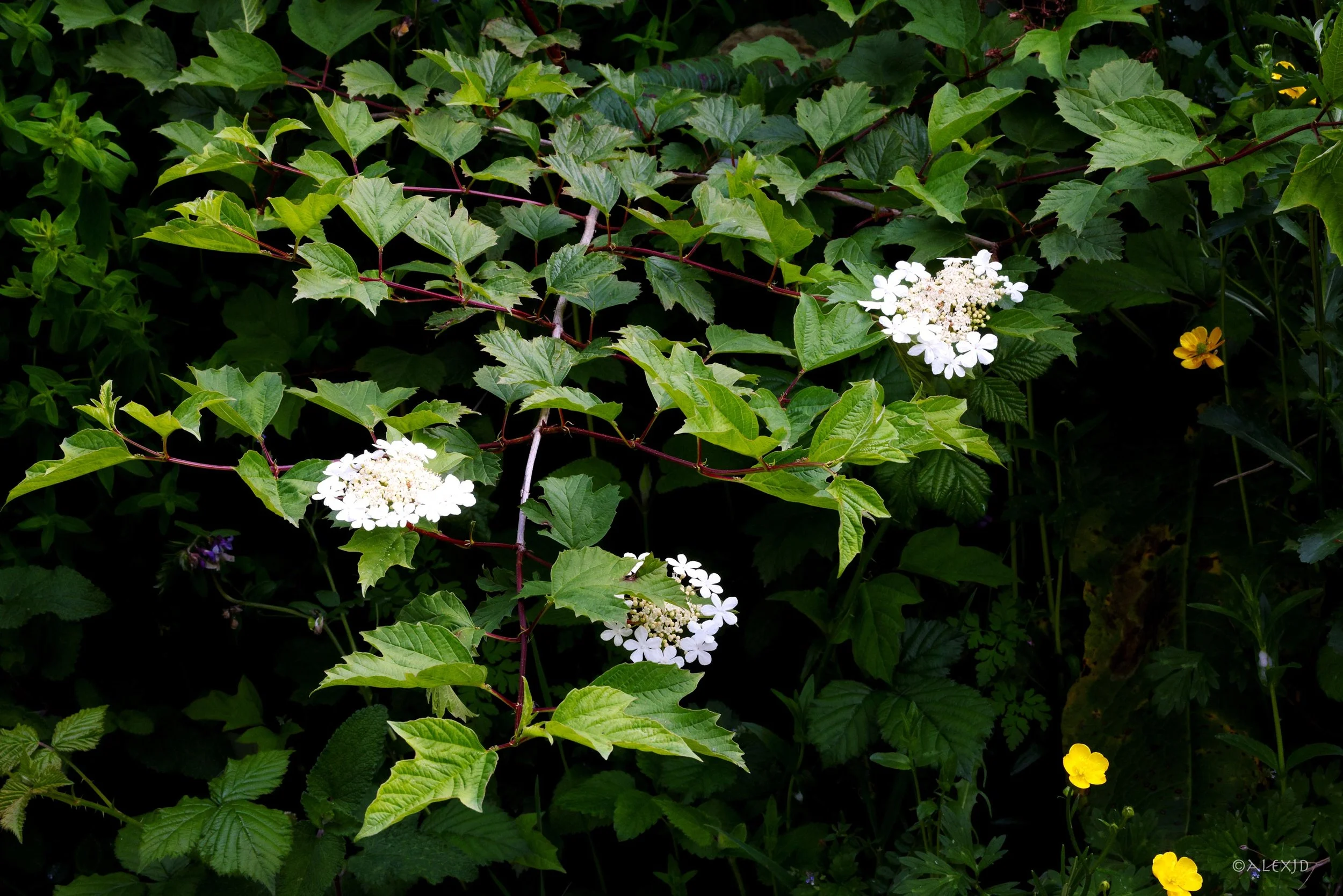Conversation with Crampbark
Crampbark High Cranberry
Viburnum opulus Caprifoliaceae
This is an invaluable medicinal plant from our native flora as well as being very beautiful. I find just sitting with the plant to be so calming and soothing, especially when its lovely white flowers are open.
Nikki's commentary
This is an invaluable medicinal plant from our native flora as well as being very beautiful. I find just sitting with the plant to be so calming and soothing, especially when its lovely white flowers are open.
It is a close relative of the elderflower, and you can see this in the similarity in the flowers.
Although the stem bark is the part traditionally recommended, myself and quite a few of my colleagues use a ‘cheat’ when preparing medicine from it. We prune the shrub and use the whole small twigs rather than peeling off the bark.
We have used the twigs to make a deep decoction, reducing the volume of the liquid to a 1/10th and the used this in cream for treating menstrual cramps and other cramps. It is amazingly effective. I also give dropper bottles of the fluid extract to women who have menstrual cramping to take- 10 drops when the period starts and then repeat every hour until the cramping stops-often one dose is sufficient. It can also help reduce heavy menstrual bleeding and is quite sedating and calming too. For heavy bleeding in the perimenopausal years, it can be very helpful, reducing both the heaviness and the anxiety that often occurs in perimenopause as oestrogen is dropping. During labour it can help to relax the uterus into effective contractions if the womb is too tense this prevents effective contractions.
I also use this amazing medicine in pain mixes as often a lot of pain is accompanied by spasms in the muscles. It is especially valuable if there is laxity or degeneration in the joints.
It can be very valuable for reducing high blood pressure if there is a lot of tension in the cardiovascular vessels or nervous tension. When people are experiencing cold hands and feet due to vasoconstriction (for example Raynaud’s or ‘white finger’) it improves the circulation by relaxing the blood vessels. I often combine it with bilberry, yarrow or ginger for this.
It can also help relax the bowel in irritable bowel syndrome and for this, I might also put in some wood betony, peppermint, fennel or chamomile.
For the respiratory system in asthma when there is bronchospasm present I combine it with Grindelia or wood betony.
Some people also tincture the berries or prepare them as an acetum. They have a brilliant red colour which they also give to the medicine and this is often used for menstrual problems.
And here is our monograph if you want any of the technical or growing stuff.
Crampbark in the house garden - Grá Nádúr
Monograph - TPMS
Crampbark High Cranberry
Viburnum opulus Caprifoliaceae
Part used:
Stem bark.
Botanical Description:
A small tree that grows up to 4 metres tall. The twigs are angular and have grey bark. The leaves have 3-5 lobes with a pair of stipules at the base of the stalks and a toothed margin. The white flowers are held in flat-topped clusters with larger ones on the periphery and smaller inner ones with a scent. The fruit is bright red. It is related to elder and honeysuckle. It grows in woodlands, hedges and thickets and can be propagated from seed sown in the autumn or from slips. It prefers a damp habitat. Native to Europe and America. Propagated from seed sown in autumn. The bark is harvested in spring and autumn.
Constituents:
Bitter resin (viburnin) Valeric acid Salicosides Tannin 3% Hydroquinone (arbutin) Coumarins (scopoletin)
Actions:
Muscle and nerve relaxant Nervine Sedative Astringent Antispasmodic
Traditional and current uses:
Cramps
Painful periods and uterine dysfunction, ovarian and uterine pain
Menopausal heavy bleeding and breakthrough bleeding
Partus praeparator – prepares for labour and during the process to ease labour pain
Bed wetting in children
Muscle spasm in the back and limbs, both internally and externally
Asthma and associated muscle tension
Constipation, colic and IBS of nervous origin and due to bowel tension
Some forms of high blood pressure
Swollen glands and mumps
Arthritis and rheumatism, where weak joints have caused muscles to go into spasm
Poor circulation to the hands and feet
For period pain doses of decoction or tincture can be taken every 3 hours - half a cup of a decoction or 5 ml of the tincture.
The berries should not be eaten raw, but are quite palatable with other autumn fruits when cooked.
Crampbark in the house garden - Grá Nádúr


